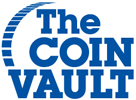If you are a fan of the show or a loyal online customer, you would have noticed the number of currency deals lately that have been offered. It is not often that we get to experience the number of currency deals we have done either, but it is something we have welcomed over the last month or so. Seeing vintage paper money alongside fractional notes, $2 red seals, funny backs, large size notes, and of course, silver certificates, is something we quite frankly enjoy.
Perhaps the most popular of deals we offer always include silver certificates. Whether they are circulated or uncirculated, include consecutive serial numbers, or have that prestigious star on them, paper money collectors are heavily involved with silver certificates. But do you know the history of the silver certificate? Sure, Andy has mentioned a brief paraphrased version on the show, but let us delve a little deeper into the appeal of the beloved currency.
Bland-Allison Act of February 28, 1878
The authorization of silver certificates first began under the Bland-Allison Act of 1878. Prior to the act, a depression set in after the Panic of 1873 (a financial crisis that affected both Europe and North America) which caused silver production interests from a Democrat of Missouri (Rep. Richard P. Bland) and a Senator from Iowa (William B. Allison) to propose that silver be purchased at market rates and be minted into silver dollars.
Although first vetoed by then-President Rutherford B. Hayes, Congress approved the act that would require the United States Treasury Department to purchase between $2 million and $4 million worth of silver each month. The act, in the grand scheme of things, allowed for people to deposit silver coins into the Treasury in exchange for paper money, or silver certificates.
Popularity Of the Silver Certificate
These silver certificates were to be in the same denominations as the United States notes as well as not hold a value less than $10 with a purpose of being an alternative to carrying around silver dollars in bulk. Much like today, the intent is understandable as paper money is much easier to tote around than a pocketful of change.
With the introduction of silver certificates, the popularity of carrying around silver dollars decreased as Congress recognized this and decided to introduce $1, $2, and $5 notes in 1886 in addition to the already select series of 1878 that offered $10, $20, $50, $100, $500, and $1,000 denominational silver certificates. The notes became a major source of currency in the late nineteenth and early twentieth centuries although by 1896, $20, $50, $100, $500, and $1,000 denominational silver certificates were no longer issued.
It was not until the mid-twentieth century that the decline of silver and silver dollars within the Treasury were apparent and therefore threatened the backing of the silver certificates. On June 4, 1963, legislation (77 Stat.54) was put into place that repealed the purchase and reserve of silver coin and bullion. Silver coins could be redeemed for silver certificates until 1968 with the production of notes stopping in 1965. They were soon replaced with Federal Reserve Notes.
Below is the total number of silver certificates produced from 1878-1965 by denomination according to the Bureau of Engraving and Printing:
- $1 - $38,549,291,941
- $2 - $1,202,718,000
- $5 - $17,115,870,850
- $10 - $2,306,881,700
Source: Bureau of Engraving and Printing
